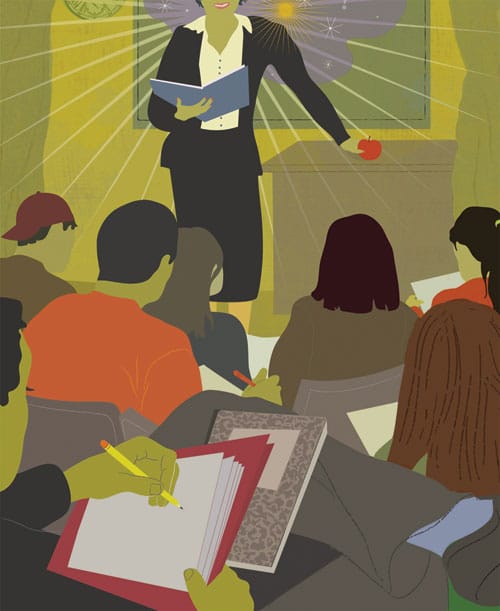
The Old College Try
When I taught first grade—before the Earth cooled, in 1969—I instructed 90 6-year-olds to read and write, add and subtract. Along the way, they also learned to cut with scissors and refrain from bonking each other on the head with their science books. In return, I learned to buckle boots, make tissue-paper flowers, and achieve some sort of primordial order on the playground.
In between then and now, I tried to teach my own kids—if not academics, then at least life lessons. You learn to give up on directing a science-fair project and just do it yourself. You can’t teach math, so you don’t try. And you never attempt driving instruction, every parent’s most stressful experience. (I let one kid off at an intersection when he argued that four-way stops were optional.) Successful tooth-brushing and table manners are all you can hope for.
Perhaps the less one is paid—parents, zero—the less success one enjoys as a teacher. This bodes poorly for today’s professionals, who I believe are treated eco-nomically about the same as street vendors. Teaching is a hard job, believe me, and good educators should be valued the same as doctors, judges, and CEOs.
Despite bad pay and a colleague’s assertion that outside professionals teaching college are driven by ego, I accepted a position as adjunct professor of magazine journalism at Butler University, which, basketball victories aside, is one of the region’s—and academia’s—major gems. I studied journalism there myself and count those years as my most inspired and energized.
I was cautioned about just how long a two-and-a-half-hour class can feel, so I overplanned every session and scheduled as many colleagues as I could cajole as guest lecturers. (A retired professor liked to tell the story of a friend who, preparing to teach his first college course, practiced his two-hour lecture in front of his wife. His remarks lasted 15 minutes, he retracted his agreement, and he never set foot in the classroom.)
Whatever my students learned over the semester—every teacher hopes for the best—I learned more. Too many years had passed for me to remember that a college campus is the best place to be, especially one as compact and lovely as Butler’s. This is a place to reflect and absorb, away from management headaches and cash-flow concerns. One-hundred-sixty milligrams of Diovan should work so well.
The duties of the classroom, however, can jolt a teacher into an almost panicked sense of responsibility. It’s one thing to sit in front of a computer, but another to stand before a class of students whose lives you could possibly change. A teacher can bore or inspire, merely educate or enlighten. One hopeful student caught up with me after class, frustrated by her performance on writing assignments. I complimented her fortitude and enthusiasm while gently nudging her toward a related—but different—field. I suspect I slept more fitfully that night than she.
Effective writing, I learned, is quite a task for many college students. They have not benefited from enough simple instruction in sentence structure, grammar, and punctuation. I slaved over grading their papers, correcting every wrong conjunction and comma, agonizing over faulty subject-verb agreement, deleting superfluous and misplaced words. Mrs. Harding, my grade-school English teacher, made us diagram sentences on paper, on the blackboard, in our heads. Not just one sentence, but every sentence, and, some 50 years later, I still divide my thoughts with vertical and slanted lines. The craft has languished without her.
Students sleep in class—I learned that, too. I don’t know why they are more tired than the rest of us, but I got an inkling on the first day of our 2:25 p.m. session, when I overheard a student say to her friend, “I’ve been in class nonstop since 8 o’clock this morning. I am soooo tired.” Alas, I wanted to mock: A cruel world awaits. They also congregate in unfortunate ways, mirroring the woes of society itself. The African-American girls sat with other African-American girls, sorority types with those just like them, the school newspaper editors with each other. No mingling here, and I pitied the sole student athlete who sat alone, in the front row, just under my nose.
I learned not to pace (the students might as well have been watching a ping-pong tournament) and to avoid the wobbly instructor’s stool. And I learned not to bother trying to execute a successful multimedia presentation, but merely ask for a volunteer. The best classes were the ones when someone else visited. Attention spans could be as short as the students’ skirts, and I learned to heed the advice of an esteemed journalism professor at another university who suggested I plan in 15-minute blocks.
Nice surprises came in the form of a creative spark or an aha moment. A headline-writing session turned out a better title for a pet story (“Furry Tale”) than the one published (“Puppy Love”). Students haven’t been slapped around by the business world; the freshness can open minds.
One impressive student tried hard for an A. She participated in class, turned in solid work, paid attention (no naps for her), led group projects. Not surprisingly, she conveyed her disappointment with her A- final grade. I’m torn between having let her down, possibly bruising her GPA or deflating her future plans, and my own disappointment that she felt entitled. There are few Mr. Holland’s Opus moments in teaching. There are no standing ovations at the last session, no bouquets of roses. Teachers are not restaurant servers who can judge their success by the amount of the tip. They impart as much knowledge and expertise as they humanly can, hope it’s enough, and turn off the lights when they leave.
Illustration by Andrea Eberbach.
This article originally appeared in the September 2011 issue.





